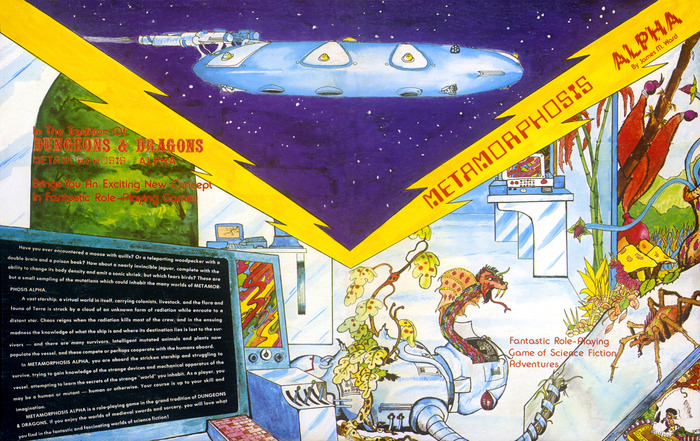I started to feel that I didn’t know roleplaying games well enough so I came up with the plan to read a roleplaying game corebook for every year they have been published. Selection criteria is whatever I find interesting.

To be honest, my first choice for 1976 was the Watership Down -inspired Bunnies & Burrows, but I was unable to find a copy. Because of this, I went with my second choice, the scifi game Metamorphosis Alpha. Perhaps this was a good thing because this was a quite interesting game!
Metamorphosis Alpha differs from the games I’ve read so far in that it has a very tight, clear focus. It’s not a sprawling mass you can use to make endless campaigns but a clear package offering a definite experience.
The story of the game is that in the future, humanity sends vast colony ships to other planets. Since the voyage is so long, these ships with populations in the millions are like mini-worlds unto themselves. As always happens in these stories, something goes wrong. Radiation kills most of the people aboard and mutates many of the rest. As a result, onboard civilization collapses.
The characters are humans, mutants, animals or plants who have been born to this environment and set out to explore it. The game is a big sandbox which offers two interesting things:
1 – The ship. The game details the tools, the robots, the levels, all the things that you find as you explore the vast space vessel. Although the game is based on the classic model of exploring physical spaces, killing monsters and finding treasure, the treasure can now be an access band allowing movement from one level of the ship to the next.
2 – Character creation. The characters in Metamorphosis Alpha can be quite bizarre. A telepathic vine is a reasonable starting character, as is a hyper-intelligent armored bear. The radiation has mutated all the biological samples on board and they’re all playable. What’s more, the system takes a reckless approach to powers, throwing things like time travel around quite casually.
Like the games I’ve read so far, this one suggests one Referee (or Judge, as the game sometimes calls it) for a maximum of 24 players. (“More the merrier”, it says.) There’s a system where human characters can accumulate followers, meaning that the character group can get quite big. The example of play is between the Referee and the Caller, the leader of the player group.
Based on reading the game, it seems best suited for one-shots or short campaigns where the chaos of the setting is allowed to bloom, all the game systems and world elements interacting in sandbox-style blissful anarchy. Perhaps because of this, there’s no level system to account for experience. It doesn’t seem like the game would go on long enough to need one.
Reading this and the previous game, 1975’s Empire of the Petal Throne, I’m struck by the explosion of creativity around roleplaying games immediately after their inception. So far, it feels like there’s so many new ideas in every game.